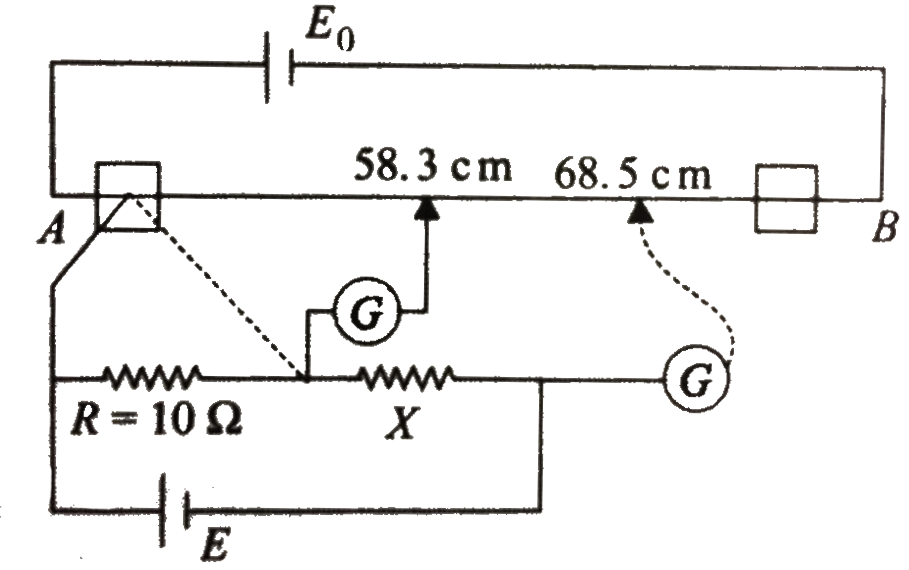The given figure shows a potentiometer circuit for comparison of two resistances. The balance point with a standard resistor R=10.0Ω is found to be 58.3 cm while that with the unknown resistance X is 68.5 cm . Determine the value of X. What might you do if you failed to find a balance point with the given cell of emf E?

When standard resistor R is connected in the circuit, the potential drop across R will be equal to that across the length of wire from end A to the balance point. Let l1 be the distance of balance point from end A with the standard resistor R. If k is the potential gradient of the potentiometer wire, then potential drop across length l1 will be. V1=kl1=IR (where I is the current in the circit) Similarly, if l2 is the distance of balance point from end A with the unknown resistance X, then the potential drop across length l2 will be:
V2=kl2=IX (current I will remain same)
∴V1V2=RX=l2l1=58.368.5
⇒X=10×68.558.3=11.75Ω
If there is no balance point, it means the potential drop across R or X is greater than the potential drop across the potentiometer wire AB. The obvious thing to do is to reduce current in the outside circuit (and hence potential drops across R and X) suitably by putting a series resistor.
Topper's Solved these Questions
- CURRENT ELECTRICITYBOOK - MODERN PUBLICATIONCHAPTER - CURRENT ELECTRICITYEXERCISE - NCERT SOLVED (NCERT Exemplar Problems Subjective Questions)(Very Short Answers Type Questions)
10 Videos
- CURRENT ELECTRICITYBOOK - MODERN PUBLICATIONCHAPTER - CURRENT ELECTRICITYEXERCISE - NCERT SOLVED (NCERT Exemplar Problems Subjective Questions)(Short Answers Type Questions)
6 Videos
- CURRENT ELECTRICITYBOOK - MODERN PUBLICATIONCHAPTER - CURRENT ELECTRICITYEXERCISE - NCERT SOLVED (NCERT Textbook Exercises)
13 Videos
- ATOMS BOOK - MODERN PUBLICATIONCHAPTER - ATOMS EXERCISE - Chapter Practice Test
16 Videos
- DUAL NATURE OF RADIATION AND MATTER BOOK - MODERN PUBLICATIONCHAPTER - DUAL NATURE OF RADIATION AND MATTER EXERCISE - CHAPTER PRACTICE TEST
15 Videos
Similar Questions
Figure 6.12 shows a potentiometer circular for comparison of two resistances. The balance point with a standard resistor R=10.0Omeag is found to be 58.3cm, while that with the unknows resistance X is 68.5cm. Determine the value of X. What would you do if you fail to find a balance point with the given cell E?

View SolutionFigure 6.12 shows a potentiometer circular for comparison of two resistances. The balance point with a standard resistor R=10.0Omeag is found to be 58.3cm, while that with the unknows resistance X is 68.5cm. Determine the value of X. What would you do if you fail to find a balance point with the given cell E?

View Solution
Knowledge Check

Figure shows a potentiometer circuit for comparision of two resistances. The balance point with a standard resistor R=10.0Ω is found to be 58.3 cm, while that with the unknown resistance X is 68.5 cm. the value of X isA11.75ΩB12.55ΩC9.55ΩD12.75Ω
In the potentimeter circuit shown in figure, the balance point with R=10Ω when switch S1 is closed and S2 is open is 50 cm, while that when S2 is closed and S1 is open is 60 cm. What is the value of x? What will you do if you fail to find a balance point with the given cell E'?

View SolutionIn a potentiometer experiment, the balancing length with a resistance of 2Ω is found to be 100cm, while that of an unknown resistance is 500cm. Calculate the value of the unknown resistance.
View SolutionA potentiometer wire of length 1.0 m has a resistance of 10Ω. It is connected to a 6 V battery in seried with a resistance of 5Ω. Determine the emf of the primary cell which gives a balance point at 40 cm.
View SolutionA potentiometer wire of length 1 m has a resistance of 10 Ω . It is connected to a 6 V battery in series with a resistance of 5 Ω . Determine the emf of the primary cell which gives a balance point at 40 cm.
View SolutionA potentiometer wire of length 1 m has a resistance of 10Ω. It is connected to a 6V battery in series with a resistance of 5Ω. Determine the emf of the primary cell which gives a balance point at 40cm.
View SolutionA potentiometer wire of length 1.0 m has a resistance of 15 ohm. It is connected to a 5 V source in series with a resistance of 5Ω. Determine the emf of the primary cell which has a balance point at 60 cm.
View SolutionA potentiometer wire of length 1 m has a resistance of 10Ω. It is connected to a 6V battery in series with a resistance of 5Ω. Determine the emf of the primary cell which gives a balance point at 40cm.
View Solution
